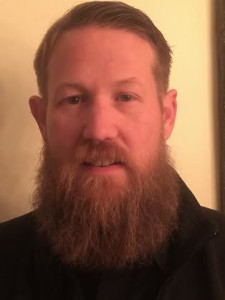Meet the AAG Journals Editors – David Butler and Nik Heynen
Published six times a year since 1911, the Annals of the American Association of Geographers is one of the world’s foremost geography journals. The articles in the journal are divided into four theme sections that reflect the various scholarship throughout the geographic discipline: Geographic Methods; Human Geography; Nature and Society; and Physical Geography, Earth and Environmental Sciences. There are editors responsible for each of the four themes, two of which are David Butler and Nik Heynen.
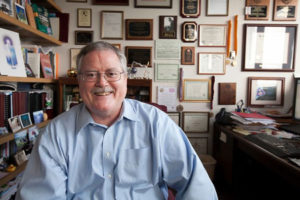 The Physical Geography, Earth and Environmental Sciences section editor of the Annals of the American Association of Geographers is David Butler. Butler is a Texas State University System Regents’ Professor in the Department of Geography at Texas State University where he teaches courses on geomorphology, landscape biogeography, biogeomorphology, and Nature and Philosophy of Geography. With research interests that include geomorphology, biogeography, natural hazards, mountain environments and environmental change, Butler has considerable experience working with physical geography topics. He has also been the recipient of several awards during his career including the Distinguished Career Award from the Biogeography Specialty Group, the Geomorphology Specialty Group, and the Mountain Geography Specialty Group of the AAG as well as a variety of teaching and mentoring awards.
The Physical Geography, Earth and Environmental Sciences section editor of the Annals of the American Association of Geographers is David Butler. Butler is a Texas State University System Regents’ Professor in the Department of Geography at Texas State University where he teaches courses on geomorphology, landscape biogeography, biogeomorphology, and Nature and Philosophy of Geography. With research interests that include geomorphology, biogeography, natural hazards, mountain environments and environmental change, Butler has considerable experience working with physical geography topics. He has also been the recipient of several awards during his career including the Distinguished Career Award from the Biogeography Specialty Group, the Geomorphology Specialty Group, and the Mountain Geography Specialty Group of the AAG as well as a variety of teaching and mentoring awards.
Aside from working with the AAG Journals, Butler has editorial experience that includes serving as Section Editor for Geomorphology for the AAG International Encyclopedia of Geography, as a section editor for the international journal Progress in Physical Geography, and as long-time book review editor for the journal Geomorphology. He has also guest edited/co-edited nine special issues of the journals Physical Geography and Geomorphology.
As an editor for AAG Journals, Butler feels a sense of satisfaction that he is helping to advance physical geography within the discipline. In his mind, the most pressing issue within physical geography right now is “figuring out how to address the concept of the Anthropocene in classical physical geography research and teaching.” For those who are looking to publish research in physical geography, David says to be sure potential authors completely understand and respect the journal to which they wish to submit research. He adds, “Beyond that, don’t give up! If you feel like you have something important enough to say to be published somewhere, you’re probably right. If your first journal of choice ultimately rejects you, take to heart their critiques and try another journal!”
 Nik Heynen is the Human Geography editor for the Annals of the American Association of Geographers, a Professor in the Department of Geography at the University of Georgia, and an adjunct Professor in the Department of Anthropology. At the University of Georgia, Heynen teaches mostly large introductory classes, in addition to graduate seminars.
Nik Heynen is the Human Geography editor for the Annals of the American Association of Geographers, a Professor in the Department of Geography at the University of Georgia, and an adjunct Professor in the Department of Anthropology. At the University of Georgia, Heynen teaches mostly large introductory classes, in addition to graduate seminars.
Heynen’s research, for which he has won several awards including the AAG’s Glenda Laws Award for geographic contributions to social justice research, focuses on urban geography, especially urban social movements and urban political ecology. He is also interested in environmental justice; food/hunger studies; race, class, and gender, and science and technology studies.
While also serving as an AAG Journals editor, over the last seven years Heynen has invested time helping to establish UGA’s Center for Integrative conservation (CICR) and for over three years served as the Director of the Integrative Conservation (ICON) PhD Program that was established by a group who came together through CICR. He recently became the Director of the Geography of the Georgia Coast Domestic Field Study Program based on Sapelo Island.
In addition to the teaching and administrative activities he does at UGA, and he is also currently an editor at a variety of outlets in addition to the Annals. He serves as an editor for Environment and Planning E: Nature and Space and was also the founding editor of UGA’s Geographies of Justice and Social Transformation book series. Since 2006 he has been involved with the journal Antipode, first as the Book Reviews and Interventions editor, than as a general member of the editorial collective and he continues to serve as a trustee of the Antipode Foundation, a U.K. based charity. Part of the work he still does at Antipode is Chair Antipode’s Institute for the Geographies of Justice (IGJ).
Heynen enjoys seeing the work of his colleagues and, as an editor, helping their work develop and be published. He believes that both Black geographies and Feminist geographies are the two most exciting areas of geographic thought at this time, but continues to find great value in Marxist Geography.
Learn more about Nik’s research by visiting his website: nikheynen.com.
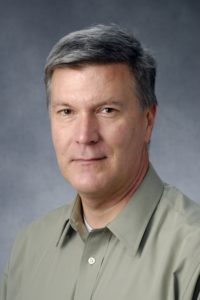 Barney Warf is the current Editor for The Professional Geographer and a Professor of Geography at the University of Kansas. His professional interests lie within the broad domain of human geography. Much of his research concerns information technology and telecommunications, notably geographies of the internet, including fiber optics, the digital divide, and e-government. He has also written on military spending, electoral geography, religious diversity, cosmopolitanism, and corruption. While most of his research involves secondary data, Barney’s most memorable research experiences have involved doing interviews in Latin America, particularly in Panama and Costa Rica, that added a human depth to the topics he researched. He has authored, co-authored, or co-edited eight research books, three encyclopedias, three textbooks, 50 book chapters and more than 100 refereed journal articles.
Barney Warf is the current Editor for The Professional Geographer and a Professor of Geography at the University of Kansas. His professional interests lie within the broad domain of human geography. Much of his research concerns information technology and telecommunications, notably geographies of the internet, including fiber optics, the digital divide, and e-government. He has also written on military spending, electoral geography, religious diversity, cosmopolitanism, and corruption. While most of his research involves secondary data, Barney’s most memorable research experiences have involved doing interviews in Latin America, particularly in Panama and Costa Rica, that added a human depth to the topics he researched. He has authored, co-authored, or co-edited eight research books, three encyclopedias, three textbooks, 50 book chapters and more than 100 refereed journal articles.
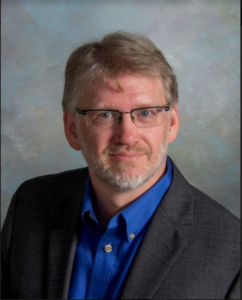 Dr. Stephen Hanna recently joined the AAG Journals’ editorial team as the Cartography Editor for the AAG suite of journals: the Annals of the Association of American Geographers, the Professional Geographer, and GeoHumanities.
Dr. Stephen Hanna recently joined the AAG Journals’ editorial team as the Cartography Editor for the AAG suite of journals: the Annals of the Association of American Geographers, the Professional Geographer, and GeoHumanities.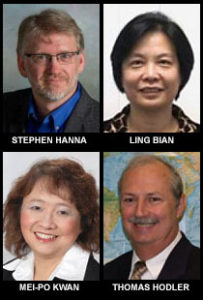 The AAG welcomes two new editors to take the positions of Cartography Editor for the AAG Journals (Annals, The Professional Geographer, and GeoHumanities) and the Methods, Models, and GIS Editor for the Annals of the AAG starting January 1, 2018. Stephen Hanna will be taking over for Cartography Editor Thomas Hodler while Ling Bian will assume the role of the Methods, Models and GIS Editor as Mei-Po Kwan steps down. The AAG would like to send a very special thank you to Thomas Hodler and Mei-Po Kwan for their years of extraordinary service in these positions.
The AAG welcomes two new editors to take the positions of Cartography Editor for the AAG Journals (Annals, The Professional Geographer, and GeoHumanities) and the Methods, Models, and GIS Editor for the Annals of the AAG starting January 1, 2018. Stephen Hanna will be taking over for Cartography Editor Thomas Hodler while Ling Bian will assume the role of the Methods, Models and GIS Editor as Mei-Po Kwan steps down. The AAG would like to send a very special thank you to Thomas Hodler and Mei-Po Kwan for their years of extraordinary service in these positions.
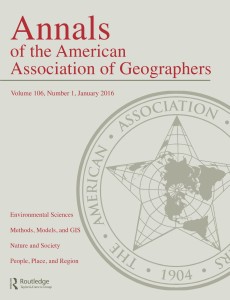 After the AAG meetings in Hawaii in 1999, a new format for the Annals of the Association of American Geographers was introduced wherein four sections and four editors were put in place to represent the breadth of the academic discipline of geography. Four major areas – (i) Environmental Sciences, (ii) Methods, Models, and Geographic Information Sciences, (iii) Nature and Society, and (iv) People, Place, and Region – were introduced as sections in the Annals to offset long-standing concerns about the lack of representation of certain aspects of the discipline (especially physical geography) in one of its flagship journals. Further, concerns about perceived biases accruing to a single editor were allayed by establishing an editorial team, with each editor taking responsibility for one of the four major subject areas.
After the AAG meetings in Hawaii in 1999, a new format for the Annals of the Association of American Geographers was introduced wherein four sections and four editors were put in place to represent the breadth of the academic discipline of geography. Four major areas – (i) Environmental Sciences, (ii) Methods, Models, and Geographic Information Sciences, (iii) Nature and Society, and (iv) People, Place, and Region – were introduced as sections in the Annals to offset long-standing concerns about the lack of representation of certain aspects of the discipline (especially physical geography) in one of its flagship journals. Further, concerns about perceived biases accruing to a single editor were allayed by establishing an editorial team, with each editor taking responsibility for one of the four major subject areas.
